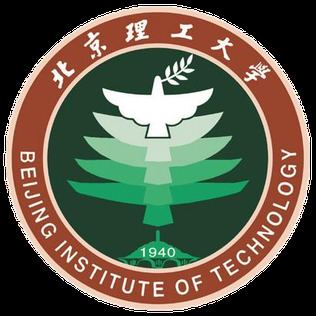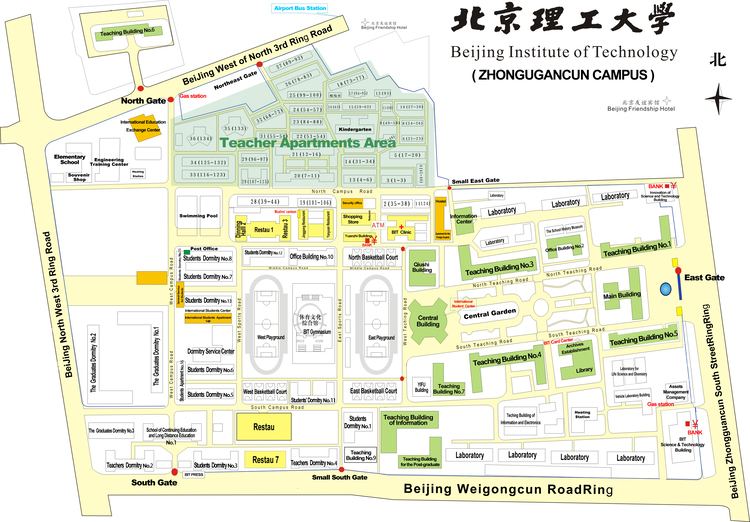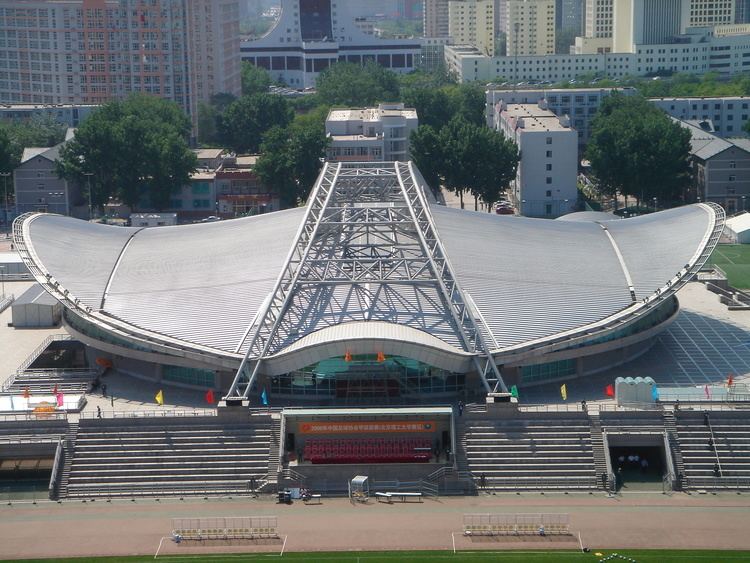Academic staff 1,953 (2010) Students 26,358 (2010) President Hu Haiyan Color Green and White | Established 1940 Administrative staff 1,489 (2010) Total enrollment 43,991 (2010) Founded 1940 | |
 | ||
Motto in English Developing virtues for seeking truth; Pursuing study for perfecting practice. Motto Unity Diligence Integrity Innovation Notable alumni Similar | ||
Beijing institute of technology
Beijing Institute of Technology (abbreviated BIT; Simplified Chinese: 北京理工大学; Traditional Chinese: 北京理工大學; pinyin: Běijīng Lǐgōng Dàxué), is a co-educational public university, located in Beijing, China, established in 1940, Yan'an. It is a major research university under the supervision of the Ministry of Industry and Information Technology.
Contents
- Beijing institute of technology
- Beijing institute of technology china
- Yanan period 1940 1946
- Shanxi Chahar Hebei Border Region period 1946 1949
- Institute of Technology North China University period 1949 1952
- Beijing Institute of Technology period 1952 1988
- Post economic reform period 1988 present
- Zhongguancun Beijing
- Liangxiang Beijing
- Xishan Beijing
- Fangshan Beijing
- Qinhuangdao Hebei
- Zhuhai Guangdong
- Schools and departments
- Academics
- Demographics
- Education
- Research
- Rankings
- Library
- Press
- Student housing
- Alumni
- Politicians
- Scientists
- Athletics
- References

As a member university of National Key Universities, Project 211 and Project 985, it has been given priority sponsor from the Chinese government, the Commission of Science, Technology and Industry for National Defense, the Ministry of Education (MOST) and the Beijing metropolitan Government.

Beijing institute of technology china
Yan'an period (1940-1946)

Beijing Institute of Technology (BIT) has its origins in the Yan'an Research Academy of Natural Sciences (延安自然科学研究院), which was established in Yan'an, northwest of China, in May 1939 by Chinese Communist Party, with the aim of training science and engineering professionals. In January 1940 when China was undergoing the most difficult phase of the War of Resistance Against Japan, the Central Committee of the Communist Party of China reformed Yan'an Research Academy of Natural Sciences into Yan'an Academy of Natural Sciences (延安自然科学院). The major mission of the Academy was to assist the industrial development in Shanxi-Chahar-Hebei Boarder Region. As the first science and engineering university founded by Chinese Communist Party, Yan'an Academy of Natural Sciences opened on 1 September 1940. Li Fuchun, the secretary of the CPC Committee for Shaan-Gan-Ning Border Region was appointed as the first president, and was succeeded by educationist Xu Teli.

During the founding period, Yan'an Academy of Natural Sciences received great support from international organizations and individuals, including Rewi Alley.
In March 1943, Yan'an Academy of Natural Sciences was merged into the newly founded University of Yan'an (延安大学), and was named as School of Natural Sciences, University of Yan'an (延安大学自然科学院).
According to the situation of the war, University of Yan'an prepared to move the north and northeast of China by the end of 1945.
Shanxi-Chahar-Hebei Border Region period (1946-1949)
In January 1946, the School of Natural Sciences moved to Zhangjiakou, but failed to continue its journey to the northeast of China due to the urgent situation of the war. The Central Bureau of Shanxi-Chahar-Hebei Border Region decided to settle the School at Zhangjiakou, and merged it with Shanxi-Chahar-Hebei Border Region College of Technology (晋察冀边区工科专门学校) to form Shanxi-Chahar-Hebei Border Region College (晋察冀边区工业专门学校).
At the end of the same year, Shanxi-Chahar-Hebei Border Region Institute moved to Bailing Village, Jianping County, Hebei, and merged with Shanxi-Chahar-Hebei Border Region Academy of Railway (晋察冀边区铁路学院) to form Shanxi-Chahar-Hebei Border Region College of Industry and Transportation (晋察冀工业交通学院), but remained respective identity. One year later, Shanxi-Chahar-Hebei Border Region Institute moved to Jingxing County, renamed as Shanxi-Chahar-Hebei Border Region Bureau of Industry College of Technology (晋察冀边区工业局工业学校). In August 1948, it was then merged with Institute of Technology, Northern University (北方大学工学院) to form Institute of Technology, North China University (华北大学工学院).
Institute of Technology, North China University period (1949-1952)
Just before the established of People's Republic of China, Institute of Technology, North China University made its final move to Beijing, and confirmed its academic focus to industrial development for the newly founded People's Republic of China. It was administrated by Ministry of Industry, and became the first university specialized in heavy industry related subjects since the foundation of the new China.
The home campus of Sino-French University (中法大学) and its Department of Mathematics, Department of Physics and Department of Chemistry were merged into Institute of Technology, North China University in October 1950, which effectively provided enough accommodations, laboratories, libraries, as well as many outstanding academics.
Beijing Institute of Technology period (1952-1988)
On 1 January 1952, Institute of Technology, North China University was officially renamed as Beijing Institute of Technology (北京工业学院). On 8 March 1952, it was decided by Ministry of Heavy Industry that Beijing Institute of Technology would be developed as a higher educational institute specialized in national defense industry, and would be a major institute for training technical professionals in national defense. Ever since then, Beijing Institute of Technolo gy started to establish a number of weaponry science and technology subjects, including China's first rocket and missile subject, with the help of many scientists such as Qian Xuesen. In the meantime, several departments were terminated and others, including biology, mining, and aeronautics, were transferred to other universities, namely China Agricultural University (1947), Beijing Steel and Iron Institute (1952) and Beijing University of Aeronautics and Astronautics (1952), respectively. In 1959, Beijing Institute of Technology was singled out as one of 16 “national key universities” that were authorized to offer graduate degrees.
During the Cultural Revolution, most research at Beijing Institute of Technology came to a halt but quickly revived after 1976.
Post-economic reform period (1988-present)
In 1988, the institution changed its Chinese name from "Institute" to "University" (北京理工大学), while the English name remained unchanged. In 1991, BIT was chosen as one of the 14 national key universities to receive special supports from the Chinese government during the Eighth Five-Year Plan.
In December 1995, BIT was ratified by the Chinese government as one of the 15 first-tier "Project 211" universities. In 1996, BIT became one of the first 32 Chinese universities to officially run graduate schools. In the same year, BIT was designated as one of the 27 national key universities during the Ninth Five-Year Plan. In 1999, BIT's undergraduate education was evaluated as "Excellent" in the assessment organized by the Chinese Ministry of Education.
In 2000, BIT was the 10th university to be admitted into "Project 985", which aimed to promote the development and reputation of the Chinese higher education system by founding world-class universities in the 21st century through prioritized supports from both national and local government funding. In the same year, BIT was also designated as one of the top 22 universities in the "21st Century Education Promotion" plan during the Tenth Five-Year Plan.
BIT used to be administered by the Commission of Science, Technology and Industry for National Defense. Since 2008, it is administered by the newly founded Ministry of Industry and Information Technology.
In November 2010, along with 8 other Project 985 universities, BIT officially formed Excellence League, an alliance of 10 Chinese universities with strong background in engineering.
BIT is traditionally strong in national defense and military technologies research, especially radars, missiles, and armored combat vehicles, but it also maintained outstanding research strength in electrical engineering, automation, photonics, mechanical engineering, chemical engineering, computer science, industrial design and many other science and engineering subjects.
As of 2015, BIT has established cooperation with more than 200 universities from 58 countries, and implemented student exchange programs with more than 40 universities in the world, including Technical University of Munich, Bauman Moscow State Technical University, Tokyo Institute of Technology, University of California and The Australian National University.
Zhongguancun, Beijing
BIT's main campus is located in Zhuongguancun area of northwest of Beijing, which is known as an area with high concentration of universities, research institutions, high-tech companies, as well as knowledge and information industries, namely the Silicon Valley of China. BIT is adjacent to National Library of China, Zhongguancun Science Park, and many other universities such as Renmin University, China Agricultural University, Beijing Foreign Studies University and Minzu University of China.
Zhongguangcun campus has an area of 920,700 square meters, including a floor space of 724,000 square meters. It is the oldest and the used to be the only campus of BIT. Since the opening of Liangxiang campus in 2007, Zhongguancun campus is mainly used to host higher year undergraduate students and postgraduate students.
Liangxiang, Beijing
Since 2007, lower year undergraduate students are hosted in Liangxiang campus, which is based in Liangxiang University Town, Fangshan District, southwest suburb of Beijing.
Xishan, Beijing
A Laboratory Research centre located in northwest of Beijing.
Fangshan, Beijing
BIT Fangshan campus was co-founded by BIT and Fangshan District government, and is located in Yancun County, Fangshan District, southwest suburb of Beijing.
Qinhuangdao, Hebei
Founded in 1984, Qinhuangdao campus offers one-year pre-university program for ethnic minority students whose first language is not Mandarin. In addition to host students who will apply to BIT, Qinhuangdao campus also accepts pre-university ethnic minority students who will apply to Beihang University, Nanjing University of Aeronautics and Astronautics, Nanjing University of Science and Technology, Harbin Institute of Technology, Harbin Engineering University and Northwestern Polytechnical University.
Zhuhai, Guangdong
Zhuhai campus is based at Zhuhai, Guangdong province in south China. The speciality of Zhuhai campus lies in providing continuing education, distance learning courses, and special courses related to local economy and industry. It is home to many research institutions co-founded by BIT and local government, including a graduate school and a science park. BITZH- CUHK Optomechatronic Engineering Joint Research Centre and BITZH- HKPU City and Public Security Joint Research Centre are also located in Zhuhai campus.
Schools and departments
Academics
BIT is an institution focusing on engineering education and research for decades, which also make it ranked top in China. While maintaining its traditional strength in engineering, BIT also pays great attention to the balanced development of other disciplines. BIT is now a multi-disciplinary university with comprehensive academic disciplines in engineering, science, management, humanities, economics, law, and pedagogy.
Demographics
The university has a range of degrees and programmes for international students, including reputable Chinese language courses and engineering degrees offered in English. As a result, there is a wide diversity of foreign students, from South Asia, Central Asia, Africa, Europe, North and South America, who study for both degree-grating and non-degree granting courses.
Education
BIT has 16 national key disciplines, 25 ministry-level key disciplines. BIT offers bachelor's degrees in 60 majors, Master's degrees in 144 majors, and Doctorate degrees in 62 majors. It also has 17 post-doctorate stations.
Research
BIT is an important research institution for military technology and is famous for its contributions to the research and development of radar, missiles, firearms and armored combat vehicles. However, some of its research are not allowed to be disclosed and a great amount of the research work cannot be published.
BIT's traditional research strength lies in Electrical Engineering (now with the Chinese name of Information Engineering), Automation, Photonics, Mechanical Engineering, Vehicle Engineering, Aerospace Engineering and Chemical Engineering. Some of its emerging research areas are also developing fast in recent years, including Computer Science, Industrial Design, and Higher education research.
BIT has five national key laboratories (research centers), six national defense key laboratories (research centers), two MOST key laboratories (research centers) and four Beijing municipal key laboratories (research centers). It also has a national key science park. The annual research expenditure in 2004 was more than 620 million RMB.
Rankings
Historically, BIT was widely considered by Chinese education officials to be among the top 20 universities in China. In recent national level evaluations, BIT was among the first 15 universities to be designated into the "Project 211". It is also the 10th university to be designated into the prestigious "Project 985". BIT ranks top 300 in the QS World University Rankings(2014), 29th in QS Asian University Rankings (2014), 39th in the BRICS University Rankings(2014) and 17th in Chinese University Rankings(2014). BIT's Engineering & Technology ranks in the top 5 among Chinese universities. According to the China Discipline Ranking conducted by the a research center affiliated with the China Ministry of Education, BIT ranks among top 10 nationally in the following ten disciplines:
Note: According to the ranking's classification of academic disciplines, BIT was evaluated in about 20 disciplines.
Library
Established in 1940, the BIT library now consists of one main library and four branch libraries. Nine new branch libraries are in construction or planning.
The renovation of the main library was completed in 2006. The state-of-the-art building has an area of 25,509 square meters and is covered by wireless network. It now has a total collection of more than 3 million items, including 1.13 million electronic items.
Press
The BIT Press was established in 1985 and has published more than 3,000 books. Most of the books published by BIT press are in the area of natural science and technology. The current director for the press is Yang Zhijian.
Student housing
All undergraduate and postgraduate students at BIT are guaranteed university accommodation. Allocation is normally on the basis of students' major, year and class etc. First and second year undergraduate students are based at Liangxiang campus. Higher year undergraduate students and postgraduate students are based at Zhongguancun campus. Both campuses also provide staff accommodation.
Alumni
Among the 100,000 BIT alumni, there are 16 Fellows of Chinese Academy of Science or Chinese Academy of Engineering, more than 70 officials with rank higher than provincial governor, and more than 40 generals for Chinese military.
Politicians
Scientists
Athletics
BIT has several collegiate sports teams. Its football team is widely considered one of the best in Chinese collegiate football. The team won 4 out of 6 national champions from 2001 to 2006, when it participated in the Chinese University Football League. The BIT team also represented Chinese football team at the 2003 Summer Universiade Game and the 2005 Summer Universiade Game. After winning the promotion to the professional football league in 2006, the team has been participating in the professional Chinese Football Association Jia League. Since 2015 the international students at BIT have their own football team, BIT International FC.
The Eastern Athletic Field is the home field for Beijing Institute of Technology FC. Currently, it is mostly used for the team's home football games in Chinese Football Association Jia League. The field is also open to students and staff of BIT for sports.
